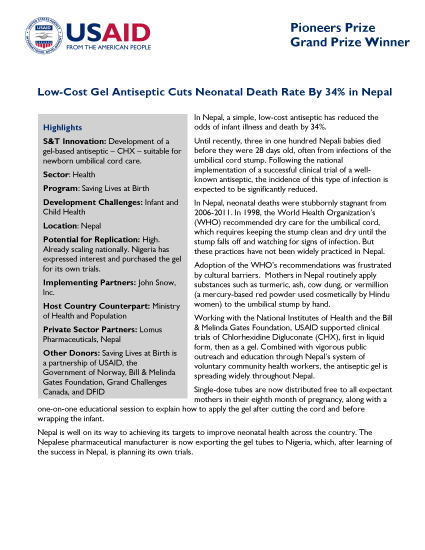Low-Cost Gel Antiseptic Cuts Neonatal Death Rate By 34% in Nepal
Highlights
In Nepal, a simple, low-cost antiseptic has reduced the odds of infant illness and death by 34%.
Until recently, three in one hundred Nepali babies died before they were 28 days old, often from infections of the umbilical cord stump. Following the national implementation of a successful clinical trial of a well-known antiseptic, the incidence of this type of infection is expected to be significantly reduced.
In Nepal, neonatal deaths were stubbornly stagnant from 2006-2011. In 1998, the World Health Organization’s (WHO) recommended dry care for the umbilical cord, which requires keeping the stump clean and dry until the stump falls off and watching for signs of infection. But these practices have not been widely practiced in Nepal.
Adoption of the WHO’s recommendations was frustrated by cultural barriers. Mothers in Nepal routinely apply substances such as turmeric, ash, cow dung, or vermillion (a mercury-based red powder used cosmetically by Hindu women) to the umbilical stump by hand.
Working with the National Institutes of Health and the Bill & Melinda Gates Foundation, USAID supported clinical trials of Chlorhexidine Digluconate (CHX), first in liquid form, then as a gel. Combined with vigorous public outreach and education through Nepal’s system of voluntary community health workers, the antiseptic gel is spreading widely throughout Nepal.
Single-dose tubes are now distributed free to all expectant mothers in their eighth month of pregnancy, along with a one-on-one educational session to explain how to apply the gel after cutting the cord and before wrapping the infant.
Nepal is well on its way to achieving its targets to improve neonatal health across the country. The Nepalese pharmaceutical manufacturer is now exporting the gel tubes to Nigeria, which, after learning of the success in Nepal, is planning its own trials.








Comment
Make a general inquiry or suggest an improvement.